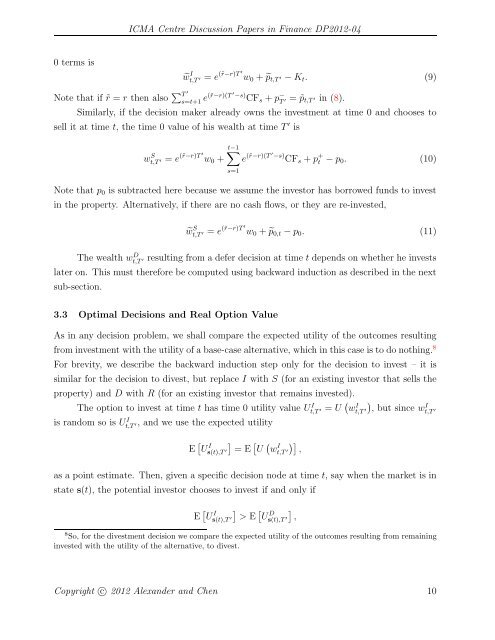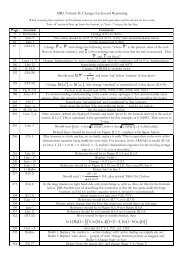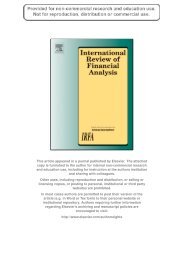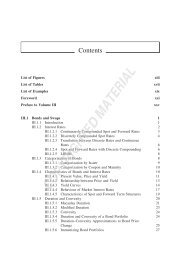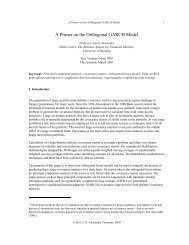<strong>ICMA</strong> <strong>Centre</strong> Discussion Papers in Finance DP2012-040termsis˜w I t,T ′ = e(˜r−r)T ′ w 0 + ˜p t,T ′ − K t . (9)Note that if ˜r = r then also ∑ T ′s=t+1 e(˜r−r)(T ′ −s) CF s + p − T=˜p ′ t,T ′ in (8).Similarly, if the decision maker already owns the investment at time 0 and chooses <strong>to</strong>sell it at time t, the time 0 value of his wealth at time T ′ iswt,T S = ∑t−1e(˜r−r)T ′w ′ 0 + e (˜r−r)(T ′ −s) CF s + p + t − p 0 . (10)s=1Note that p 0 is subtracted here because we assume the inves<strong>to</strong>r has borrowed funds <strong>to</strong> investin the property. Alternatively, if there are no cash flows, or they are re-invested,˜w S t,T ′ = e(˜r−r)T ′ w 0 + ˜p 0,t − p 0 . (11)The wealth wt,T D ′ resulting from a defer decision at time t depends on whether he investslater on. This must therefore be computed using backward induction as described in the nextsub-section.3.3 Optimal Decisions and <strong>Real</strong> <strong>Option</strong> ValueAs in any decision problem, we shall compare the expected utility of the outcomes resultingfrom investment <strong>with</strong> the utility of a base-case alternative, which in this case is <strong>to</strong> do nothing. 8For brevity, we describe the backward induction step only for the decision <strong>to</strong> invest – it issimilar for the decision <strong>to</strong> divest, but replace I <strong>with</strong> S (for an existing inves<strong>to</strong>r that sells theproperty) and D <strong>with</strong> R (for an existing inves<strong>to</strong>r that remains invested).The option <strong>to</strong> invest at time t has time 0 utility value Ut,T I = U ( )w I ′ t,T , but since wI ′ t,T ′is random so is Ut,T I ′, and we use the expected utilityE [ U I s(t),T ′ ]=E[U(wIt,T ′)],as a point estimate. Then, given a specific decision node at time t, saywhenthemarketisinstate s(t), the potential inves<strong>to</strong>r chooses <strong>to</strong> invest if and only ifE [ U I s(t),T ′ ]> E[UDs(t),T ′],8 So, for the divestment decision we compare the expected utility of the outcomes resulting from remaininginvested <strong>with</strong> the utility of the alternative, <strong>to</strong> divest.Copyright c○ 2012 Alexander and Chen 10
<strong>ICMA</strong> <strong>Centre</strong> Discussion Papers in Finance DP2012-04and we setE [ { [ [U s(t),T ′]=max E UIs(t),T ′], E UDs(t),T ′]}. (12)]Since there are no further decisions following a decision <strong>to</strong> invest, E[Us(t),T I can be evaluated′directly, using the utility of the terminal wealth ] values obtainable from state s(t) andtheirassociated probabilities. However, E[Us(t),T D depends on whether it is optimal <strong>to</strong> invest or′defer at the decision nodes at time t + 1. Thus, the expected utilities at each decision nodemust be computed via backward induction.First we evaluate (12) at the last decision nodes in the tree, which are at the timeT that option expires. These nodes are available only if the inves<strong>to</strong>r has deferred at everynode up <strong>to</strong> this point. We associate each ultimate decision node <strong>with</strong> the maximum value(12) and select the corresponding optimal action, I or D. Now select a penultimate decisionnode; say it is at time T − kΔt. If we use a recombining binomial tree <strong>to</strong> model the marketprice evolution, it has 2 k successor decision nodes at time T . 9 Each market state s(T − kΔt)has an associated decision node. Each one of its successor nodes is at a market state s ∗ (T )that is attainable from state s(T − kΔt), and has an associated probability π s ∗ (T ) determinedby the state transition probability of 0.5, given that we employ the parameterisation (2). 10Using the expected utility associated <strong>with</strong> each attainable successor node, and their associatedprobabilities, we compute the expected utility of the decision <strong>to</strong> defer at time T − kΔt. Moregenerally, assuming decision nodes occur at regular time intervals, the backward inductionstep is:E [ ] ∑Us(t−kΔt),T D = π ′ s ∗ (t)E [ ]U s ∗ (t),T ′ , t = kΔt, 2kΔt,...,T − kΔt, T. (13)s ∗ (t)At each decision node we compute (13) and associate the node <strong>with</strong> the optimal action and itscorresponding maximum expected utility. We repeat the backward induction until we arriveat a single expected utility value associated <strong>with</strong> the node at time 0. Finally, the option valueis the certain equivalent (CE) of this expected utility, less the initial wealth w 0 . By definition,CE(w) =U −1 (E[U(w)]) for any mono<strong>to</strong>nic increasing utility U.9 The recombining assumption simplifies the computation of expected utilities at the backward inductionstep. However, we do not require that the binomial tree is recombining so the number of decision nodes couldproliferate as we advance through the tree. Note that the state price tree will recombine if cash flows aredetermined by a time-varying but not state-varying dividend yield.10 So if the tree recombines these probabilities are 0.5 k ,k0.5 k ,k!/(2!(k − 2)!)0.5 k , ...., k0.5 k , 0.5 k under theJR parameterization (2). If the CRR parameterisation is employed instead the transition probabilities for arecombining tree would be more general binomial probabilities.Copyright c○ 2012 Alexander and Chen 11


